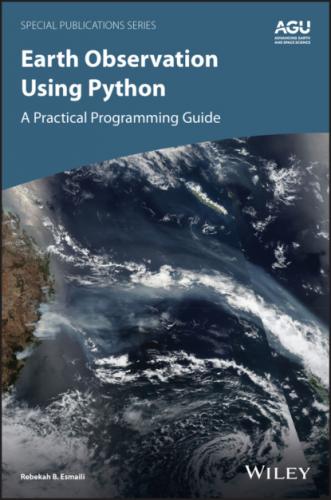Table of Contents
1 Cover
4 Foreword
7 Part I: Overview of Satellite Datasets 1 A TOUR OF CURRENT SATELLITE MISSIONS AND PRODUCTS 1.1 History of Computational Scientific Visualization 1.2 Brief Catalog of Current Satellite Products 1.3 The Flow of Data from Satellites to Computer 1.4 Learning Using Real Data and Case Studies 1.5 Summary References 2 OVERVIEW OF PYTHON 2.1 Why Python? 2.2 Useful Packages for Remote Sensing Visualization 2.3 Maturing Packages 2.4 Summary References 3 A DEEP DIVE INTO SCIENTIFIC DATA SETS 3.1 Storage 3.2 Data Formats 3.3 Data Usage 3.4 Summary References
8 Part II: Practical Python Tutorials for Remote Sensing 4 PRACTICAL PYTHON SYNTAX 4.1 “Hello Earth” in Python 4.2 Variable Assignment and Arithmetic 4.3 Lists 4.4 Importing Packages 4.5 Array and Matrix Operations 4.6 Time Series Data 4.7 Loops 4.8 List Comprehensions 4.9 Functions 4.10 Dictionaries 4.11 Summary References 5 IMPORTING STANDARD EARTH SCIENCE DATASETS 5.1 Text 5.2 NetCDF 5.3 HDF 5.4 GRIB2 5.5 Importing Data Using Xarray 5.6 Summary References 6 PLOTTING AND GRAPHS FOR ALL 6.1 Univariate Plots 6.2 Two Variable Plots 6.3 Three Variable Plots 6.4 Summary References 7 CREATING EFFECTIVE AND FUNCTIONAL MAPS 7.1 Cartographic Projections 7.2 Cylindrical Maps 7.3 Polar Stereographic Maps 7.4 Geostationary Maps 7.5 Creating Maps from Datasets Using OpenDAP 7.6 Summary References 8 GRIDDING OPERATIONS 8.1 Regular One‐Dimensional Grids 8.2 Regular Two‐Dimensional Grids 8.3 Irregular Two‐Dimensional Grids 8.4 Summary References 9 MEANINGFUL VISUALS THROUGH DATA COMBINATION 9.1 Spectral and Spatial Characteristics of Different Sensors 9.2 Normalized Difference Vegetation Index (NDVI) 9.3 Window Channels 9.4 RGB 9.5 Matching with Surface Observations 9.6 Summary References
